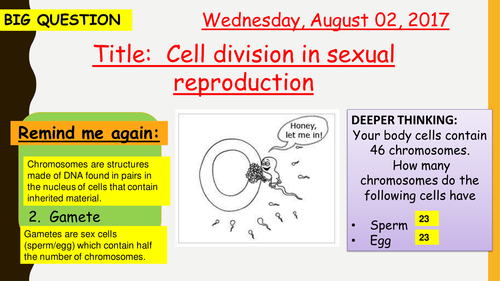

Cell division in sexual reproduction, otherwise known as meiosis lesson created in accordance to the NEW AQA Specification (9-1). Designed for a separates class, although content can be adjusted to suit any ability. Includes: slide animations, embedded timers, practice questions with answers on slides, quiz and 6 mark past paper question with ms. *Knowledge of the stages of meiosis is not required.*
AQA spec link: 6.1.1
Relevant chapter: B13 Genetics and reproduction. AQA Biology third edition textbook-Page 198-199.
Specification requires students to know the following; 6.1.2
Students should be able to explain how meiosis halves the number of chromosomes in gametes and fertilisation restores the full number of chromosomes.
Cells in reproductive organs divide by meiosis to form gametes.
When a cell divides to form gametes:
• copies of the genetic information are made
• the cell divides twice to form four gametes, each with a single set of chromosomes
• all gametes are genetically different from each other.
Gametes join at fertilisation to restore the normal number of chromosomes. The new cell divides by mitosis. The number of cells increases. As the embryo develops cells differentiate.
AQA spec link: 6.1.1
Relevant chapter: B13 Genetics and reproduction. AQA Biology third edition textbook-Page 198-199.
Specification requires students to know the following; 6.1.2
Students should be able to explain how meiosis halves the number of chromosomes in gametes and fertilisation restores the full number of chromosomes.
Cells in reproductive organs divide by meiosis to form gametes.
When a cell divides to form gametes:
• copies of the genetic information are made
• the cell divides twice to form four gametes, each with a single set of chromosomes
• all gametes are genetically different from each other.
Gametes join at fertilisation to restore the normal number of chromosomes. The new cell divides by mitosis. The number of cells increases. As the embryo develops cells differentiate.
Get this resource as part of a bundle and save up to 42%
A bundle is a package of resources grouped together to teach a particular topic, or a series of lessons, in one place.
Something went wrong, please try again later.
This resource hasn't been reviewed yet
To ensure quality for our reviews, only customers who have purchased this resource can review it
Report this resourceto let us know if it violates our terms and conditions.
Our customer service team will review your report and will be in touch.
£4.00
